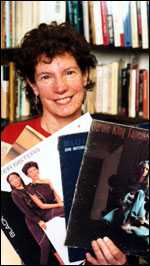You reached this page through the archive. Click here to return to the archive.
Note: This article is over a year old and information contained in it may no longer be accurate. Please use the contact information in the lower-left corner to verify any information in this article.
History professor examines women's lives through lens of popular culture
March 17, 2003
To Judy Kutulas, a professor of history at St. Olaf College who focuses on 20th century history and U.S. women's history, understanding the popular culture of the 1970s is essential to understanding the tumultuous decade that preceded it.
 Music and television provide clues to contemporary American culture, says Professor of History and Director of Women's Studies Judy Kutulas. Photo by Paul Johnson '02. |
"Pop culture of the 1970s mirrors the changes that took place in the '60s," says Kutuluas, who recently published an article on women's music from the '70s, a decade in which Joni Mitchell, Carole King and Carly Simon were the undisputed queens of pop music -- reflecting the emerging strength and vitality of women's roles.
Tapestry, the best-selling album by King, became a "huge touchstone" for women, Kutulas says, and a break from the male-dominated rock 'n' roll of the previous decade. "The women's movement spawned so many changes in women's lives, from marrying later to attending graduate school to having some disposable income of their own as women moved into careers.
"The female singer-songwriters captured those changes," says Kutulas, 50, who still plays the record albums about which she writes. "Their work was introspective and personal. It was a blueprint for how women were feeling. And it wasn't innocent, like the so-called girl groups of the early '60s. These women wrote and sang about desire and sexuality, but it was from a female point of view."
By the end of the decade, however, she notes, women's music was portraying liberation almost solely in sexual terms, thanks to the disco craze and the popularity of performers such as Donna Summer.
Kutulas' essay on women's music, called "You Probably Think This Song is About You: Women's Music from Carole King to the Disco Divas," was published in January in an anthology titled Disco Divas: The Women's Liberation Movement in Popular Culture, edited by Sherrie Inness, by the University of Pennsylvania Press.
Earlier, Kutulas published an academic article on maternity stories from situation comedies on TV, from "I Love Lucy" to "Murphy Brown."
Kutulas is sharing her research with students -- showing them how pop music provides clues to contemporary American culture. "I was very conscious of the changing gender context within which I lived my life," she says, "but I did not realize that I was also living through a turning point in women's music."
King and Simon, in particular, Kutulas notes, offered young women assertive songs about relationships that were more blatantly physical than the songs of the Supremes and other "girl groups." They also modeled a way of life that fell into a comfortable niche between June Cleaver and radical feminism.
While the women's music of that period adopted the "Annie Hall view of relationships" -- in which it was assumed no one "right" person was out there, just a series of relationships that would run their course -- Kutulas still finds an air of domesticity in the lyrics of King, Simon and the others. Women were powerful enough to challenge "the way I've always heard it should be" but still yearned to feel feminine, like a "natural woman."
The pendulum began to swing the other way when male singers who were comfortable performing in stadiums started muscling aside female artists who preferred smaller venues -- and began complaining musically about women with too much power. No surprise, then, that the "disco divas" of the later 1970s were more akin to the female musicians of the 1950s and '60s -- people who performed music rather than creating it.
A member of the St. Olaf faculty since 1986, Kutulas teaches history, American studies and women's studies courses. She is an authority on the American Civil Liberties Union and the transformation of American liberalism between 1930 and 1960. Her article "Pretty Darn Chic: The American Civil Liberties Union in the 1930s," was published in Mid-America, vol. 83, in fall 2001.
Currently she is working on an article on how TV situation comedies from the 1970s reflected gender roles and especially the changes in women's lives.
For more information about Judy Kutulas, see http://www.stolaf.edu/people/kutulas/.
